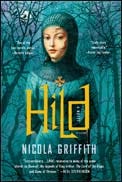Hild founded the Abbey of Whitby and became its abbess in 657 A.D. She governed both monks and nuns at this Celtic-style double monastery. Griffith’s novel imagines Hild’s life in rich, thorough detail, beginning with her early childhood in pagan times when her father, a nephew of King Edwin of Northumbria, was murdered. Hild and her remaining family were taken in by King Edwin, and she was still a child when Edwin married a Christian princess who brought a chaplain to the king’s household. The mass baptisms that eventually followed are, in this novel, portrayed as conversions more political than spiritual, with Hild's no exception.
The novel portrays Hild as the pagan she must have been before her baptism, thoughtful rather than devout, an extraordinarily intelligent woman whose gifts as a seer, uncanny though they might seem to others, come from her perceptive awareness of the world around her. She is a keen observer of the behavior of birds and animals, harbingers of weather patterns or armies on the march; as well as the behavior of men and women, harbingers of war, peace and the diplomatic maneuverings in between. Hild and the people of her world are brought to life with gritty realism and great personality. This long novel, sometimes lyrical, sometimes graphically violent, comes to a close with a dramatic fictional turning point in Hild's life and that of her adored half-brother. She is still a young woman, not yet a nun, so a sequel (Menewood) follows.
Readers may have some difficulty keeping track of every character in the numerous cast, most with authentically spelled Anglo-Saxon names like Æthelburh, Coelfrith and Eanflæd, and of the complex web of relations among seventh-century Britain's many kings and chieftains. Major characters are memorable, though, and as the novel progresses, Hild's story becomes ever more absorbing, the scenes more vivid. For readers unfamiliar with historical fiction, this novel may not be the best introduction, but if you can't get enough of early Britain during the transition between paganism and Christianity, it's a must-read. (2013, 546 pages including a glossary and an Author's Note on the history behind the novel)





I have the sequel, Menewood, on a hold request at the library right now. So looking forward to more of of Hild's story!
You're right, I must read!!